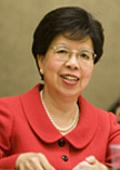H1N1 Flu Could Mutate in Southern Hemisphere, Experts Warn
GENEVA, Switzerland, May 24, 2009 (ENS) - Health authorities around the world must be vigilant as the new H1N1 influenza virus meets seasonal flu viruses circulating in the Southern Hemisphere during the winter season, warns the head of the UN World Health Organization.
"The current winter season gives influenza viruses an opportunity to intermingle and possibly exchange their genetic material in unpredictable ways," WHO Director-General Margaret Chan said Friday in her closing remarks to the World Health Assembly in Geneva.
The week-long World Health Assembly gathered officials from WHO's 193 member countries for an annual review of the agency's activities and to set new priorities for the future.
One month after the outbreak of the new flu, Dr. Chan said WHO expects it to continue spreading to new countries and within nations already affected.
 |
Dr. Margaret Chan addresses the World Health Assembly. (Photo courtesy WHO) |
As of Saturday morning, WHO figures show that 43 countries have officially reported 12,022 cases of H1N1 infection, including 86 deaths.
The virus is beginning to appear in Southern Hemisphere countries, with Argentina, Brazil, Chile, Colombia, and Peru as well as Australia and New Zealand each reporting a few cases. There have been no large scale infections and no cases have been reported in Africa.
The greatest number of cases has been confirmed in the United States, which reports 6,552 cases with nine deaths.
Mexico reports the next greatest number of cases - 3,892 cases with 75 deaths. In Mexico City, which had the largest numbers of severe cases and deaths, flu activity is decreasing, WHO reports.
WHO experts do not predict a dramatic jump of severe or fatal infections, but Dr. Chan warned that countries where the virus already is widespread should expect to see more cases of severe and fatal infections, even though a sudden and dramatic jump is not expected at present.
She said countries in the developing world "should prepare to see more than the present small number of severe cases which are being picked up under the best detection and testing conditions possible."
 |
Visitors to New York City from Venezuela are prepared to encounter the H1N1 virus. (Photo by Victor Hernandez) |
Still, Dr. Chan said that the pandemic alert level remains at Phase 5 on a six-point warning scale, meaning that sustained human-to-human transmission of the virus on a community level is mostly restricted to a single geographic region, in this case North America.
Phase 6, the pandemic phase, is characterized by community level outbreaks in at least one other country in a different WHO region in addition to the criteria defined in Phase 5.
A declaration that the world has entered Phase 6 would mean that a full-scale global pandemic is underway.
Dr. Chan said Friday, "The decision to declare an influenza pandemic is a responsibility that I take very, very seriously."
During the World Health Assembly's high-level consultation on pandemic influenza, several country delegations called on WHO to consider criteria other than geographic spread when evaluating the phases of influenza pandemic alert.
On a teleconference with reporters Friday, WHO Assistant Director-General Dr. Keiji Fukuda said new criteria for a Phase 6 declaration are under consideration.
"This request fromm countries has been very interesting and has led to intense discussion," he said. "We will be looking for events that signify real increase in threat of harm to people. That's what Phase 6 is intended to convey."
Dr. Fukuda said, "From the outset we've emphasized that there is much that we don't understand and much that will evolve. We're not sure what will happen in the Southern Hemisphere and in the fall-time."
"It's not clear to me that severity would be the only thing that would be considered for Phase 6," he said.
"The bottom line," Dr. Fukuda said, "is that we are trying to walk a fine line between not raising panic and also not becoming complacent."
Copyright Environment News Service (ENS) 2009. All rights reserved.
To subscribe or visit go to: http://www.ens-newswire.com